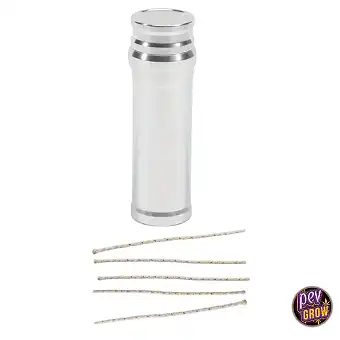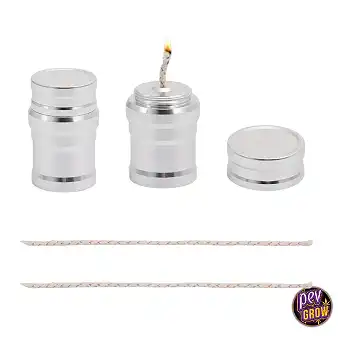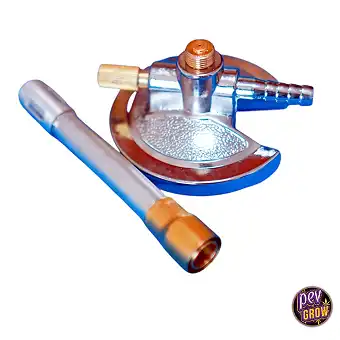Bunsen Burner
The Bunsen burner is the standard for a clean and controllable flame thanks to its air-gas mixture and adjustable blue flame. It is ideal for sterilizing tools, bending glass, or heating parts with precision and safety.
In this guide, you will learn how to choose a gas Bunsen burner based on flow rate, regulations, and base, as well as safe usage and maintenance guidelines. We include a FAQ section and links to main categories of Pevgrow to complete your order.
What is a Bunsen burner and why is it the reference for a clean flame?
The Bunsen burner is a gas burner with adjustable air intake that produces a blue flame, stable and high-temperature. Unlike a conventional lighter, the pre-mixing of air with gas optimizes combustion, reduces soot, and provides a defined hot spot for fine work. Due to its robust design, heavy base, and air control, it is perfect for those who need to heat, seal, or sterilize consistently.
In home or workshop environments, a laboratory Bunsen burner facilitates tasks such as sterilizing scissors, disinfecting metal tips, or heating small glass accessories. Its simple operation —open gas, adjust air, and ignite with a spark lighter— makes the Bunsen burner a tool that is as precise as it is safe when used correctly.
How to choose your gas Bunsen burner: regulation, nozzle, and base
To make the right purchase, consider these key points:
- Air regulation: the intake ring defines the air-gas ratio. Good regulation allows you to switch from yellow flame (more visible, less hot) to blue flame (hotter, cleaner, and quieter).
- Nozzle and diffuser: models with internal diffusers distribute gas better and stabilize the flame; look for nozzles compatible with standard tubes.
- Stable base: a heavy and wide base reduces the risk of tipping over, especially when working on vibrating tables.
- Type of gas: confirm compatibility (e.g., butane/propane) and use appropriate regulators. A well-adjusted Bunsen burner always prioritizes safety.
- Ignition: some kits include a spark lighter or piezoelectric ignition. If not, use a long lighter with total caution.
Expert tip: if you seek maximum cleanliness and temperature, work with the blue flame open just enough for your task. Avoid excess flow to improve efficiency and safety.
Common uses of the Bunsen burner in workshop and laboratory
The blue flame of the Bunsen burner is useful for sterilizing metal tools before fine cuts, heating tips, bending wires, or curving light glass with control. It also helps release thermal adhesives or adjust small accessories without charring. Thanks to its concentrated heat column, the application is precise and repeatable, with less waste than other open flame sources.
Remember to work in ventilated areas, free of flammable materials, and with appropriate supports. Safety, along with methodical handling, prolongs the life of your tools and improves the quality of the final result.
Safety: good practices with your Bunsen burner
- Work on a stable surface, clear and heat-resistant; keep a flame extinguisher or metal cover handy.
- Ventilate the area and check for leaks with soapy water before use; never bring your face close to the nozzle when igniting.
- Adjust the air ring until you achieve a clear blue flame; avoid drafts that destabilize the plume.
- Do not leave the equipment unattended and always turn off the gas valve when finished.
- Use gloves and tongs to handle hot pieces; wait for them to cool before storing.
Maintenance and care of the Bunsen burner
Basic maintenance ensures safety and performance. Periodically check the condition of the gas tube, seals, and air ring; remove dust from the intakes to avoid irregular combustion. If you notice flame backflow or unusual noises, cut the gas, let it cool, and clean the nozzle and diffuser. Store the Bunsen burner in a dry place, away from fuels, and protect the threads to keep the regulation fine over time.
FAQ about Bunsen burner
What is the difference between a Bunsen burner and a handheld torch?
The Bunsen mixes air-gas before combustion to produce a stable and wide blue flame; a torch concentrates a more focused jet. Choose Bunsen for sterilizing and heating evenly.
What gas does a laboratory Bunsen burner work with?
Generally with butane or propane depending on the model. Use compatible regulators and check connections before igniting.
How do you achieve the correct blue flame?
By adjusting the air ring until the flame is blue, quiet, and with a defined inner cone. Avoid excess gas that yellows the plume.
Is it safe to use indoors?
Yes, with ventilation, stable surface, and without flammable materials around. Never leave it unattended and cut the gas when finished.
What maintenance does it need?
Cleaning of air intakes, checking the hose and seals, and removing dust from the nozzle/diffuser. If there are anomalies, turn off and check before continuing.
Conclusion: precision and safety with Bunsen burner
If you are looking for a stable blue flame, fine regulation, and durability, the Bunsen burner is your ally. Its design focused on safety and clean combustion allows you to work with order and efficiency, from small sterilizations to precise heating.
Complete your order with main categories from Pevgrow to receive everything in a single shipment and optimize your workspace. Precision, control, and peace of mind in every ignition.
Among all of you who comment or send us your questions there will be a bimonthly draw for a 50 euros voucher to buy in Pevgrow. What are you waiting for? Write now and participate!










